On February 5, 1983, a front-page article in the New York Times by Harold C. Schonberg proclaimed the discovery of Mozart's earliest symphony—the Symphony in A Minor (K16a).1 Schonberg declared that "with such authorities as Jens Peter Larsen of Copenhagen University and Jan LaRue of New York University vouching for the authenticity of the manuscript, few will doubt the findings."2 The next day Larsen made similar assertions in the Sunday Telegraph.
A program shown on the Arts & Entertainment Network in January 1985 produced further claims that K16a was by Mozart.3 The program included a musical discussion of the symphony by Larsen that presented almost foolproof evidence that it was by Mozart, and also cited LaRue and Alan Tyson in support of the symphony's genuineness. Several reviewers of the program stated that the performance of the A Minor Symphony convinced them it was by Mozart.4 Furthermore, in his notes to the premiere recording, Robert Dearling concluded that K16a was by Mozart.5 Finally, the acceptance of the symphony as genuine Mozart has gone so far that Stanley Sadie included it among the authentic symphonies in the latest updating of The New Grove Mozart.6
While K16a has been widely accepted as a Mozart symphony, a few scholars have raised serious doubts about its genuineness. Neal Zaslaw and Cliff Eisen questioned the symphony on both documentary and general stylistic grounds. They concluded that K16a belongs in a list of Mozart's doubtful works, but that it cannot be proven spurious.7 Eva Badura-Skoda reached the same conclusion in her article on K16a.8
DOCUMENTARY EVIDENCE
Gunnar Thygesen, librarian of the Odense (Denmark) Symphony, discovered manuscript parts for K16a in 1982. The manuscript had been found with other works when the cellar of the Odense county hall was cleaned out in 1943, and the manuscripts were donated to the Odense Symphony. No one had closely examined the manuscripts before Thygesen. The watermark indicates that the paper dates from 1779 and comes from Annonay, a small town forty miles south of Lyon, France.9 The Odense Music Club apparently acquired the manuscript in 1793. It was labeled as a symphony for ten instruments and contained the ascription "del sigr Mozart." Thygesen stated that "Initially I thought that the piece might have been written by another Mozart, possibly the great composer's father, but our research has shown that the way the music is written, its types and moods, makes us certain that it is genuine."10 After consulting with LaRue, Larsen agreed.11
Scholars had conjectured the existence of K16a long before the discovery of the Odense manuscript. The incipit of the symphony appeared in a Brietkopf & Härtel manuscript catalogue of Mozart's works, indicating they once had the piece in their archives.12 They stated that they had obtained the composition from the Hamburg music dealer Johann Christoph Westphal. Westphal had advertised an A Minor symphony for ten instruments by Mozart in 1786, which is probably K16a.13
Several scholars have hypothesized that K16a was among the thirteen early symphonies listed in Leopold Mozart's catalogue of his son's works written between his seventh and twelfth years. (Neal Zaslaw in an article on this catalogue believes that it was completed between November 12th and December 16th, 1768).14 The listing reads "13 Synfonien à 2 Violini, 2 Hautb, 2 Corni, Viola, e Basso."15 Erich Hermann Müller von Asow and Karl Franz Müller included 16a as one of the early symphonies, while Zaslaw tentatively accepted it among the group in his article on the catalogue.16
Based on the documentary evidence, Alfred Einstein moved the symphony from the appendix of the Köchel Mozart Catalogue, where it was listed as K. Anh. 220, to the authentic works when he revised Köchel.17 Later editions of Köchel have kept K16a with the authentic symphonies.18 The entry in Köchel is probably the main reason that some scholars have so quickly accepted K16a as genuine Mozart.
In summary, four pieces of documentary evidence support the authenticity of K16a:
- a set of manuscript parts in Odense, Denmark;
- a listing in the Breitkopf & Härtel manuscript catalogues of Mozart's works;
- an advertisement by Westphal for an A Minor Symphony; and
- evidence from Leopold Mozart's catalog of his son's works that there are several missing symphonies.
There are problems with all the above items. First, one cannot connect the Odense manuscript with Mozart or any of his regular copyists. An attribution in a source that cannot be connected with the composer is not a reliable indicator of authenticity. Misattributions in secondary manuscripts were common in the eighteenth century, especially for popular composers. The reasons for this range from mistake to fraud.19 Second, the Breitkopf & Härtel catalogues contain several misattributions. K16a is listed as number 62 in catalogue S10, and it is grouped with three symphonies obtained from Westphal (nos. 61, 63, 64). Of these, one (K Anh C11.06) is by Leopold, another (K Ahn C11.08) is lost and usually considered doubtful, and the third (K318) is definitely authentic. Third, since Breitkopf & Härtel acquired K16a from Westphal, one cannot regard the Westphal advertisement as conclusive evidence for the symphony's authenticity.
Finally, while it is probable that there are several lost early symphonies based on the Leopold Mozart catalogue, one cannot automatically assume that K16a is among them. To begin with, its instrumentation does not match. There are two bassoons in the Odense source that are not listed in Leopold's catalogue. These bassoons are independent parts and do more than just double the bass line. More important is the date of K16a; to be one of the symphonies in Leopold's catalogue, it must have been composed before the end of 1768. Proposed dates for K16a vary from 1764/65 to 1768 to the late 1760s. Dearling, Schonberg, and Einstein favor 1764/65, Larsen 1768, and Sadie the late 1760s.20 I believe, however, that the symphony, if by Mozart, must have been written slightly later (early to mid 1770s), based on aspects of instrumentation (especially the treatment of the bass line), the use of minor and the influence of the Sturm und Drang, and form.21 If I am correct, K16a cannot be among the symphonies listed in Leopold's catalogue, which would weaken the case for its authenticity.
Zaslaw and Eisen make another attack on the documentary support for the symphony. They believe that the Odense manuscript was acquired from Westphal, which, if true, would mean that all attributions for K16a derive from the same source.22 They base their theory on evidence that the club had dealings with Westphal and correspondences between the Odense register and the Westphal catalogue. However, they fail to explain why a work obtained from a Hamburg music dealer in 1793 has a southern French watermark dating from 1779.
GENERAL STYLISTIC EVIDENCE
K16a comprises three movements: an Allegro Moderato in sonata form (Example 1), an Andantino in sonatina form (Example 2), and a Rondo Finale, also Allegro Moderato (Example 3). The outer movements are in A Minor, while the slow movement is in the tonic major. The opening movement typifies the Sturm und Drang style with quick dynamic changes, wide leaps in the melodic line, frequent repetition, and a great deal of dissonance, including diminished seventh chords (Examples 1, 4, 5). Its most unusual feature is that the exposition ends in VI (F major) rather than the relative major (C major). The lyrical second movement contrasts sharply with the intense opening movement. It is marked by dynamic contrasts and considerable ornamentation (Examples 2, 6). The rondo falls into A(i)-B(III)-A(i)-C(I)-D(i)-A(i) form. The C section is partially a variation on A (compare Examples 3 and 7), but it contains a new middle section, making it a miniature a-b-a form and eight measures longer than the sixteen-measure A.
Example 1. I, mm. 1-3

Example 2. II, mm. 1-4

Example 3. III, mm. 1-4, vn. I & bass

Example 4. I, mm. 9-11

Example 5. I, mm. 7l-73

Example 6. II, mm. 16-20

Example 7. III, mm. 48-52

The stylistic evidence that scholars have adduced concerning the authorship of K16a has been conflicting. Larsen has noted melodic and formal similarities between K16a and K43, K45, K45a, K48, and K134.23 Dearling finds Mozart's style in the mixture of stylistic influences; "the extensive use of the downward opening stroke," which at one point "bears a striking resemblance to the opening stroke of Symphony No. 21" (K134); "the characteristically Mozartean use of the fp dynamic" in the second movement; and the suggestion in the finale of "the 'Turkish music' Mozart was to write later and the folklike Kehraus finales of Leopold's occasional music."24
While believing the general style of K16a resembles that of several early Mozart symphonies and that there are also similarities on a more detailed level, Zaslaw and Eisen have detected traits that are unlike Mozart's early symphonies: the exposition of the first movement ends in F major (VI); the motivic content of the first movement is derived from the first three measures (as opposed to Mozart's usual practice of using several themes); all three movements are in some form of A; the outer movements are both Allegro Moderato (Mozart usually has finales faster than the opening); cellos and basses are divisi in the first movement; it contains notations not common in early Mozart, such as ff, mancando, smorzando; and the horn writing is conservative.25
While some of these traits do occur occasionally in Mozart's early symphonies (for example, ff appears in m. 57, concertmaster's part of an authentic version of K45a/I), certain of them do raise suspicions whether Mozart wrote K16a. Especially striking is the divisi bass line. Mozart's first confirmed use of a divisi bass line in a symphony is K318 from 1779, well after he could have written K16a.
A SYSTEMATIC STYLISTIC STUDY OF K16A
It is apparent that one cannot make a definitive case for the authenticity or nonauthenticity of K16a based on documentary or general stylistic evidence. While documentary support for K16a is weak and inconclusive, there is no documentary evidence, such as a conflicting attribution, that Mozart did not write the symphony. Similarly, stylistic discussions of K16a have been conflicting. Finally, careful scholars, such as Larsen and Zaslaw, have examined the existing evidence and come to opposite conclusions.
What is needed is a more rigorous stylistic study of K16a. Several scholars have developed systematic stylistic methods for determining authenticity, including Jan LaRue, Marvin Paymer, and the present author.26 In the following pages, I shall present my method for determining authenticity, then apply the method to K16a.
THE METHOD
I developed a method for determining authenticity by style for a study of Haydn's early instrumental works, and I have also applied the method to the music of Hoffstetter, Pleyel, Pergolesi, and three minor Renaissance composers.27 As employed here, the method consists of drawing up a stylistic checklist containing positive traits that occur in all compositions from a group of selected previously-authenticated works by a particular composer (Control Group I; in this paper, authentic Mozart symphonies) and negative traits that appear in none of the pieces, and testing the doubtful works (pieces whose authenticity is in question, in this case, K16a) against the checklist. Control Group I should include compositions of the same type as the doubtful ones (compare minuets of symphonies with minuets of symphonies), and it should cover the entire period in which the doubtful pieces could have been composed. The final checklist generally comprises from ten to twenty traits.
One finds traits by searching works in Control Group I for characteristics that might be consistent throughout the entire group. To find such traits, it is best to concentrate on one part of a movement (such as the opening measure), one instrument (the first violin), or one element of style (rhythm, texture, range) at a time. Characteristics are usually minor aspects of style, traits that are often ignored in analyses made for understanding the music, but which are important in establishing authenticity. To find negative traits, it is easiest to look at works not by the composer of the authentic pieces (in this study, non-Mozart symphonies), and see if the characteristics in these compositions occur in the authentic works in Control Group I. Traits that have proven most effective in previous studies include rhythms not found in a composer's works, characteristics in the main voices (i.e., first violin, bass), traits at important places in the movement (first measure, last measure), and aspects of texture and range.
After completing a list of potential characteristics valid for all authentic works in Control Group I, I test the traits against a group of comparable pieces by a wide variety of composers not including the composer of the Control Group I works (Control Group II—in this paper, non-Mozart symphonies, generally ten to twenty compositions). I reject positive traits that appear in more than 60% of the Control Group II works and negative traits that occur in less than 40% of this group from the checklist because they are too much a part of the contemporary vernacular. (One should list the percentage of Control Group II pieces that contain a trait after the characteristic on the charts. See Charts 1, 3, 5).
Next, one establishes the scoring. To pass a positive characteristic, a work must contain all parts of that trait, and to pass a negative characteristic, it must contain no part of the trait. Most characteristics receive one point, but I weight those traits that are valid for one or none of the Control Group II pieces with two points. One takes authenticated compositions by the main composer of the same time and period as the Control Group I works that were not used in this group (Test Group I; in this paper, additional Mozart symphonies) and employs the lowest score of these pieces to establish the lowest passing score. One then determines the midpoint between the lowest passing score from Test Group I and the highest score of the pieces in Control Group II and gives everything between the midpoint and the lowest passing score to the borderline category and everything below the midpoint to the failing category. For example, if the lowest passing score is 12 and the highest Control Group II score is 7, 12 and above would be passing, 10-11 borderline, and below 10 failing. (The midpoint between 7 and 12 is 9.5). It is best to have at least two points in the borderline category to separate passing and failing distinctly. Not only does this make the results more convincing, it compensates for a small number of errors that may occur during a study.
After completing the checklist, one should test it with additional pieces by the composer (Test Group I: authentic Mozart symphonies) and not by the composer (Test Group II: non-Mozart symphonies).28 All authentic works must pass the checklist and all pieces not by the main composer must fail. If this doesn't happen, the checklist must be revised and retested. When the validity of the profile has been proven, one can test the doubtful pieces against it.29
The above method for determining authenticity by style may be summarized as follows:
Step 1: assemble four groups of compositions. Control Group I—a set of previously-authenticated works by the main composer of the same type and period as the doubtful pieces (authentic Mozart symphonies); Control Group II—a set of works not by the main composer, also of the same time and genre as the doubtful pieces (non-Mozart symphonies); Test Group I—additional comparable works by the main composer (additional Mozart symphonies); and Test Group II—additional comparable works not by the main composer (additional non-Mozart symphonies);
Step 2: draw up a preliminary checklist of positive and negative characteristics that are valid for all authentic compositions in Control Group I;
Step 3: refine the checklist by rejecting those positive traits that appear in more than 60% of the Control Group II works and those negative traits that occur in less than 40% of the pieces;
Step 4: establish the scoring criteria. a) Most characteristics receive one point; weight those characteristics that appear in one or no works with two points. b) To establish passing, take the lowest score of the authentic compositions in Test Group I and make that the lowest passing score. Then, to establish borderline and failing, take the midpoint between the lowest passing score and the highest score of the Control Group II works and give everything between the midpoint and the lowest passing score to the borderline category and make everything below the midpoint failing.
Step 5: test additional compositions by the main composer (Test Group I) and not by the main composer (Test Group II) against the checklist;
Step 6: test the doubtful works.
The above method has proven very reliable in previous studies. In my study on the authenticity of Haydn's early instrumental compositions, only one multimovement work (out of ninety-eight studied) showed conflicting results on the tests. (For one work, two movements passed while a third failed.) Moreover, all non-Haydn movements examined in the study failed the tests (over 400 non-Haydn movements tested), while all authentic Haydn movements passed. Therefore, in the present study, it is statistically remote that a spurious work would pass all three Mozart checklists below or that an authentic Mozart work would fail all three.
THE TESTS
I developed three checklists to study the authenticity of K16a:
- fast first movements in 4-4;
- the first sections of slow movements in 2-4 with repeat signs; and
- fast finales in 2-4.
Each Control Group I consisted of relevant movements from Mozart's concert symphonies composed between 1764 and 1775, the years that K16a must have been written if by Mozart.30 I withheld several compositions from Control Group I, so that they could be used in Test Group I. I included at least twenty comparable non-Mozart pieces in each Test Group II, and I tested other doubtful Mozart symphonies with K16a (K42a, K731, K73q).31 (On the charts below, works by or attributed to Mozart are designated by their K6 numbers, while non-Mozart symphonies are identified by their opus numbers, Garland Symphony Series thematic index numbers, or key.)
PROFILE I: FAST FIRST MOVEMENTS IN 4-4
The first checklist was for fast first movements in 4-4. Twenty Mozart concert symphonies written before 1778 include such a movement. I withheld five of these symphonies from Control Group I (K19a, K45a, K132, K161a, and K162b)32 so that they could be used in Test Group I and establish the scoring criteria.
The checklist contained thirteen traits (see Chart 1) with No. 13 weighted double because it appeared in only one of the Control Group II works (maximum score 14). All traits except No. 4 apply only to expositions. Because the lowest a Mozart symphony in Test Group I scored was 12 and the highest a non-Mozart symphony in Control Group II scored was 7 (see Chart 2), I made 12-14 passing, 10-11 borderline, and below 10 failing. (The midpoint between 7 and 12 is 9.5.) All authentic Mozart symphonies in Test Group I passed, while all non-Mozart symphonies in Control Group II and Test Group II failed, demonstrating the checklist's effectiveness in separating authentic Mozart from works by other composers (see Chart 2).
Chart 1. Checklist for Fast First Movements in 4-4
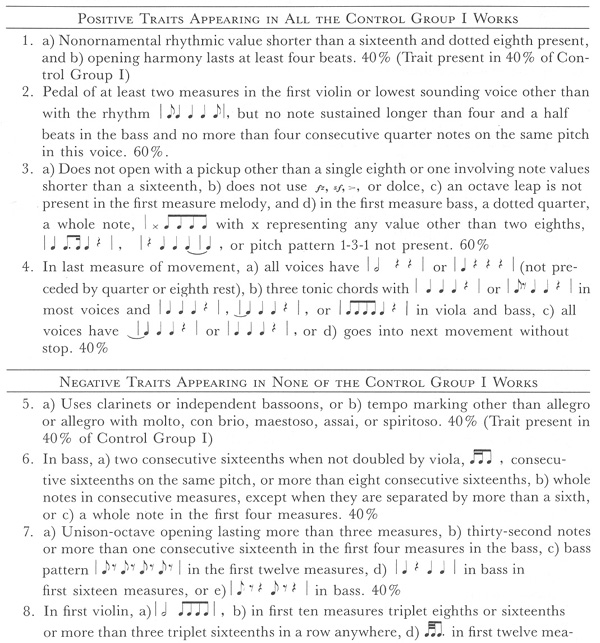
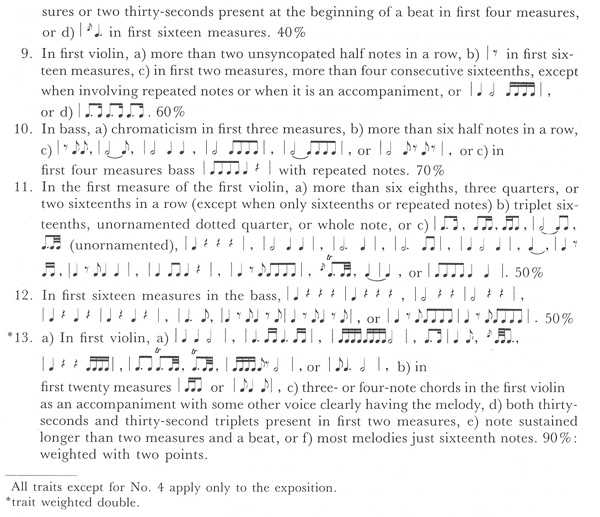
Chart 2. Results for Profile I
________________
A.
B.
C.
D.Control Group I: Non-Mozart Symphonies
Abel op. 1, no. 6: 7 (f)
Adlgasser 121: 7 (f)
Albrechtsberger 4: 6 (f)
J.C. Bach op. 6, no. 5: 7 (f)
Gassmann Hill 26: 7 (f)
Test Group I: Authentic Mozart Symphonies
19a: 13 (p)
45a: 12 (p)
132: 12 (p)
Test Group II: Non-Mozart Symphonies
Abel op. 1, no. 1: 8 (f)
Anfossi D36: 8 (f)
Auman 1: 6 (f)
J.C. Bach op. 6, no. 6: 8 (f)
Bárta G1: 8 (f)
Berlin D2: 8 (f)
F.X. Duek F7: 8 (f)
Eberlin G1: 4 (f)
Gassmann Hill 64: 7 (f)
J. Haydn 39: 8 (f)
J. Haydn 44: 8 (f)
Holzbauer op. 4, no. 1: 8 (f)
16a and Other Doubtful Mozart Symphonies
16a: 5 (f)
42a: 9 (f)
J. Haydn 49/II: 6 (f)
M. Haydn 40: 5 (f)
Le Duc 2: 6 (f)
Vanhal 11: 5 (f)
Wagenseil E3: 7 (f)
161a: 12 (p)
162b: 12 (p)
Kammel D: 7 (f)
L. Mozart1: 7 (f)
Mysliveček D: 8 (f)
Ordoñez I:G1: 6 (f)
Orlowski 1: 8 (f)
Paradeiser 2: 7 (f)
Rosetti F1: 8 (f)
Sammartini 6: 8 (f)
C. Stamitz op. 13, no. 6: 6 (f)
Zechner Q:C2: 6 (f)
*C11.02: 8 (f)
*C11.04: 9 (f)
731: 12 (p)
73q: 13 (p)
Passing 12-14, borderline 10-11, failing below 10.
*formerly attributed to Mozart, 1Sinfonia Burlesca, p = pass, f = fail.
PROFILE II: THE FIRST SECTIONS OF SLOW MOVEMENTS IN 2-4 WITH REPEAT SIGNS
I made the second checklist for the first part of slow movements in 2-4 with repeat signs. I based it on fifteen authentic works, with six other authentic pieces (K19a, K43, K73m, K124, K173da, and K186b) reserved for Test Group I. Eleven traits formed the checklist (see Chart 3) with Nos. 7 and 10 receiving two points because they didn't appear in Control Group II.10-13 was passing, 8-9 borderline, and below 8 failing. (8 is the midpoint between 5 and 11.) All authentic Mozart symphonies passed the checklist, while all non-Mozart symphonies failed (see Chart 4). The second movement of K16a failed with a score of 5 (see Chart 4).
Chart 3. Checklist for the First Sections of Slow Movements in 2-4 with Repeat Signs
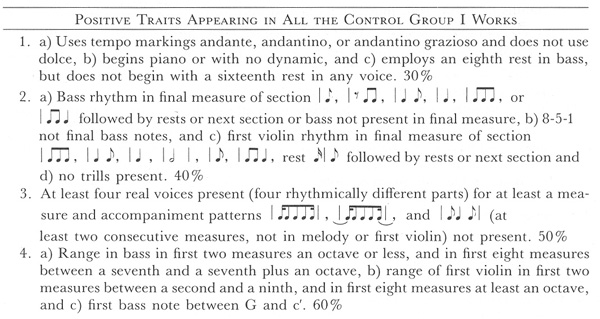
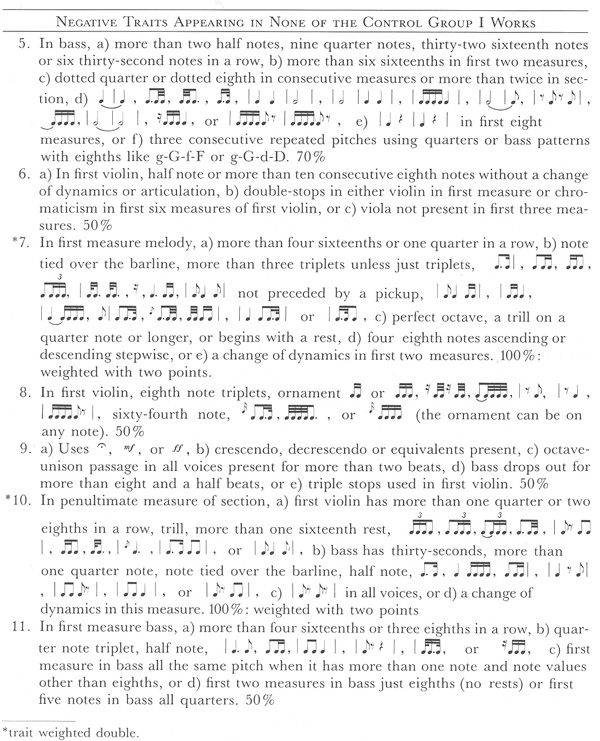
Chart 4. Results for Profile II
________________
A.
B.
C.
D.Control Group I: Non-Mozart Symphonies
Abel op. 1, no. 3: 3 (f)
Adlgasser 121: 5 (f)
Albrechtsberger 4: 5 (f)
Gassmann Hill 62: 5 (f)
J. Haydn 50: 3 (f)
Test Group I: Authentic Mozart Symphonies
19a: 10 (p)
43: 12 (p)
73m: 10 (p)
Test Group II: Non-Mozart Symphonies
Abel op. 1, no. 1: 6 (f)
Adlgasser 124: 3 (f)
Auman 1: 5 (f)
Bárta G1: 6 (f)
Boccherini op. 21, no. 5: 6 (f)
Brunetti 20: 5 (f)
Collett op. 2, no. 5: 5 (f)
F.X. Duek F7: 6 (f)
J .A. Fisher 5: 6 (f)
Gassmann Hill 23: 6 (f)
M. Haydn 20: 6 (f)
Kammel D: 6 (f)
16a and Other Doubtful Mozart Symphonies
16a: 5 (f)
M. Haydn 17: 3 (f)
Ordoñez C14: 3 (f)
Vanhal Em1: 3 (f)
Wagenseil E3: 3 (f)
Zechner Q:C1: 4 (f)
124: 10 (p)
113da: 10 (p)
186b: 10 (p)
Kraus VB 128: 6 (f)
L. Mozart G: 6 (f)
L. Mozart B: 6 (f)
Piscator 2: 6 (f)
Rosetti F1: 4 (f)
Saint-Georges 1: 6 (f)
Sammartini 18: 4 (f)
Schneider Q:C1: 6 (f)
C. Stamitz op. 13, no. 5: 6 (f)
Wagenseil B4: 6 (f)
*C11.02: 5 (f)
*C11.04: 6 (f)
731: 11 (p)
Passing 10-13, borderline 8-9, failing below 8.
*formerly attributed to Mozart.
PROFILE III: FAST FINALES IN 2-4
The last checklist was for fast finales in 2-4. Eleven authentic works contain such a movement; I withheld two of them (K74 and K124) for Test Group I. I created a checklist of twelve items (see Chart 5) with Nos. 7 and 9 weighted with two points. Passing was 11-14, borderline 9-10, and failing 8 and below. (8.5 is the midpoint between 6 and 11.) K74 and K124 passed, while all non-Mozart symphonies failed (see Chart 6). Again, K16a failed.
Chart 5. Checklist for 2-4 Finales
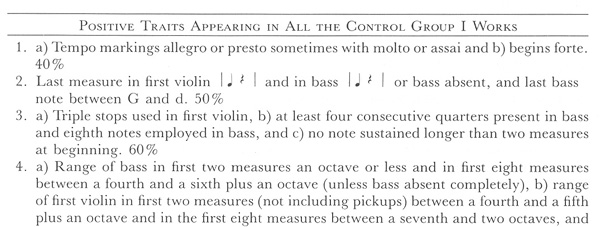
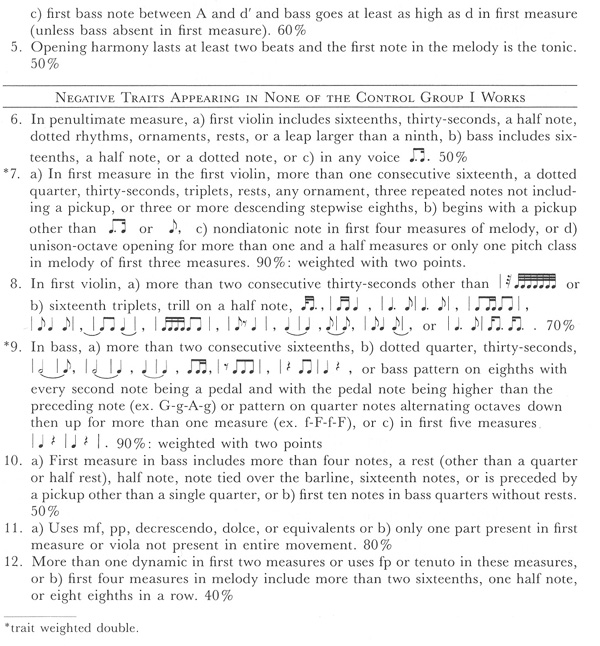
Chart 6. Results for Profile III
________________
A.
B.
C.
D.Control Group I: Non-Mozart Symphonies
Abel op. 1, no. 2: 5 (f)
Adlgasser 121: 3 (f)
Albrechtsberger 5: 6 (f)
J.C. Bach op. 6, no. 4: 5 (f)
Gassmann Hill 26: 6 (f)
Test Group I: Authentic Mozart Symphonies
74: 11 (p)
Test Group II: Non-Mozart Symphonies
C.P.E. Bach Wq 183, 2: 3 (f)
J.C. Bach op. 18, no. 1: 7 (f)
Bárta G1: 7 (f)
Beck op. 4, no. 1: 7 (f)
Brunetti 9: 3 (f)
Eichner op. 7, no. 5: 5 (f)
Gassmann Hill 86: 6 (f)
Golabek D1: 3 (f)
Gossec op. 8, no. 2: 3 (f)
J.E. Hartmann 1: 4 (f)
J. Haydn 42: 5 (f)
16a and Other Doubtful Mozart Symphonies
16a: 4 (f)
42a: 7 (f)
M. Haydn 20: 6 (f)
Le Duc 2: 4 (f)
Novotny 2: 6 (f)
Paradeiser 4: 5 (f)
Rosetti F1: 6 (f)
124: 13 (p)
M. Haydn 40: 4 (f)
Monn D: 7 (f)
L. Mozart D: 5 (f)
Naumann C: 6 (f)
Orlowski 1: 7 (f)
Richter op. 4, no. 5: 6 (f)
Sammartini 19: 5 (f)
Toeschi op. 3, no. 3: 7 (f)
Wagenseil D: 5 (f)
*C11.04: 6 (f)
73q: 11 (p)
Passing 11-14, borderline 9-10, failing below 9.
*formerly attributed to Mozart.
CONCLUSION
K16a failed all three checklists. Because it is statistically remote that an authentic symphony would fail all three, one may conclude that K16a is not by Mozart.33
Because the attribution in the Odense source is Signor Mozart, one might conjecture that the symphony is by Mozart's father. However, the symphony is even less in Leopold's style than that of his son.34 It is hard to imagine Leopold writing the Sturm und Drang opening movement. While there is another unrelated Mozart (Philip Kajatan), it is probable that the Mozart attribution is a mistake. The Zaslaw-Eisen article mentions several possibilities for K16a's composer: Daniel Heartz believes he is probably French, a German working in France, or a Frenchman working in Germany; Zaslaw is reminded of George Anton Benda and Joseph Martin Kraus; and Sadie thinks it might be North German.35
While my tests prove that Mozart could not have written K16a, a major problem remains: informing and convincing the general public. It is highly unlikely that there will be a front-page article in the New York Times or a cable television program announcing that K16a is not by Mozart. Moreover, even when a work is proven spurious, the ascription to a famous composer tends to endure.36 Hopefully, in the future, journalists and musicologists will be more careful in establishing a work's authenticity before proclaiming a major new discovery.
1Harold C. Schonberg, "Mozart's Earliest Symphony, Composed at 9, is Discovered," The New York Times (February 5, 1983), 1, 11.
2Ibid., p. 11.
3"The Mozart Miracle," Arts & Entertainment Network, January 11, 1985, 9 p.m.. Hosted by Tom Hulce; script by E.F. Nielsen and Curtis Davis.
4For example, Leighton Kerner, "Lost and Found," The Village Voice 30/7 (February 12, 1985), 79 and Donald Rosenberg, "A Fascinating Program: 'The Mozart Miracle'," Akron Beacon Journal (January 10, 1985).
5Robert Dearling, "Notes" to "W.A. Mozart: The First Three Symphonies & Symphony K16a 'Odense'," Unicorn DKP 9039, 1984.
6Stanley Sadie, The New Grove Mozart (New York: Norton, 1984), 193.
7Neal Zaslaw and Cliff Eisen, "Signor Mozart's Symphony in A Minor, K. Anhang 220 = 16a," Journal of Musicology 4 (1984-85): 191-206.
8Eva Badura-Skoda, "'Die Odense-Symphonie' KV16a—Eine Symphonie von Mozart?," Österreichische Musik-Zeitschrift 40 (1985): 311.
9According to Tyson on "The Mozart Miracle."
10Quoted in Schonberg, p, 11.
11Ibid.
12"Thematisches Verzeichnis der sämtlichen Werke von W.A. Mozart, Manuscript ehemals im Archiv des Hauses Breitkopf & Härtel," Leipzig. The original of this catalogue was destroyed in World War II, but a copy by Köchel is in the Gesellschaft der Musikfreunde in Vienna. The symphony is No. 62 in catalogue S10.
13Incomplete copies of this catalogue exist in the Bibliothèque Royale in Brussels and the Gesellschaft der Musikfreunde in Vienna.
14Neal Zaslaw, "Leopold Mozart's List of His Son's Works," in Music in the Classical Period, ed. Allan W. Atlas (New York: Pendragon Press, 1985), 332.
15Wolfgang Amadeus Mozart: Verzeichnis aller meiner Werke und Leopold Mozart: Verzeichnis der Jugendwerke W.A. Mozarts, ed. E. Müller von Asow (Wiesbaden: Ludwig Doblinger, 1956), 2.
16Müller von Asow; K.F. Müller, W.A. Mozarts Gesamtkatalog seiner Werke. "Köchel-Verzeichnis" (Vienna: Kaltschmid, 1951), 17-28; and Zaslaw, 332. Zaslaw's opinion in this article is apparently earlier than his differing opinion in the article on 16a.
17Ludwig Ritter von Köchel, Chronologisch-thematisches Verzeichnis sämtlicher Tonwerke Wolfgang Amade Mozarts, 3rd ed., ed. Alfred Einstein (Ann Arbor: Edwards, 1937).
18Köchel, Chronologisch-thematisches Verzeichnis, 7th ed., ed. F. Giegling, A. Weinmann, and G. Sievers (Wiesbaden: Breitkopf & Härtel, 1965).
19See Jan LaRue, "Major and Minor Mysteries of Identification in the Eighteenth-Century Symphony," Journal of the American Musicological Society 13 (1960): 181-85 and Scott Fruehwald, Authenticity Problems in Joseph Haydn's Early Instrumental Works: A Stylistic Investigation (New York: Pendragon Press, 1988), 3-7.
20Dearling; Schonberg; Köchel Verzeichnis, 3rd ed.; "The Mozart Miracle"; and Sadie, 193.
21Mozart's first Sturm und Drang-influenced work, the overture to La Betulia liberata, was written in 1771.
22Zaslaw and Eisen, 196-98.
23"The Mozart Miracle."
24Dearling.
25Zaslaw and Eisen, 201-3.
26Jan LaRue, "Mozart or Dittersdorf," Mozart-Jahrbuch, 1971/72, 40-49; Marvin Paymer, The Instrumental Music Attributed to Giovanni Battista Pergolesi: A Study in Authenticity (Ph.D. diss., City University of New York, 1977); and Scott Fruehwald, Authenticity Problems, 17-37.
27The studies of Pleyel and Hoffstetter can be found in my Authenticity Problems, a study of Pergolesi's sacred works was done for the Pergolesi Complete Edition, and the studies of the M. I pieces in Perugia 431 and the chansons of Fresneau and Pietrequin are unpublished.
pieces in Perugia 431 and the chansons of Fresneau and Pietrequin are unpublished.
28The works in Control Group II and Test Group II should be by a wide variety of composers, but also include several pieces that are similar in style to the works of the main composer (pieces by contemporary composers who worked in the same place or influenced the main composer). A proper selection of compositions for these groups makes it unnecessary to examine all contemporaneous works. My previous studies have demonstrated that ten to twenty pieces should be included in each group; any more than twenty greatly increases the work involved without appreciably increasing the reliability of the results.
29I should add that it is necessary for one person to do the entire study to insure consistency; scholars analyze aspects of style differently. However, separate studies done by two scholars using a properly-developed stylistic method that is applied consistently and accurately should produce the same conclusions.
30Only one symphony in minor exists in this group (173dB), but my previous studies on authenticity (and an investigation in progress on the chronology of Haydn's early instrumental works, including "The Chronology of Haydn's Early Keyboard Trios: A Method for Determining Chronology by Style," Journal of Musicological Research 7 (1987): 369-96) have shown that the mode or key of a composition makes no difference on how it scores on the profiles. The authentic group does not include serenades or opera overtures that were adapted as concert symphonies. There is a break in Mozart's symphonic production between 1775 and 78.
31Most Mozart scholars consider K42a questionable and K731 and K73q probably authentic. K731 is also attributed to Leopold Mozart, while K73q is also ascribed to Leopold, Dittersdorf, and others.
32I purposely kept K19a and K45a out of Control Group I because they have only recently been established as authentic.
33I also concluded that K731 and K73q were authentic, while K42a is spurious.
34Zaslaw and Eisen, 204-5, also concluded that the symphony is not by Leopold Mozart.
35Ibid., 206.
36For example, when I was looking through recordings of Haydn's works, I found numerous pieces attributed to Haydn that were definitely not by him, including recordings of the op. 3 string quartets, op. 5 flute quartets, a flute concerto, an oboe concerto, a number of wind divertimentos, the Feldparthien that include the one based on the "St. Anthony Chorale," and the "Echo" divertimento. Spurious works formerly attributed to Pergolesi similarly are still recorded and performed under his name.


